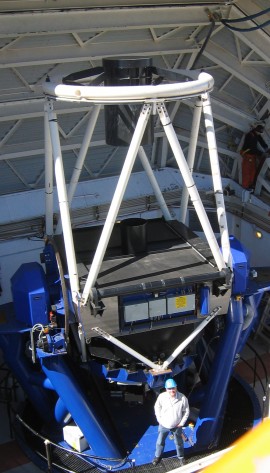Science with the Liverpool Telescope

The Liverpool Telescope (LT) is the world's largest fully robotic telescope and is a cutting edge instrument for learning more about the Universe. Designed to work autonomously, it is ideal for studying objects that change with time - from orbiting asteroids to catastrophic exploding supernovae.
However, as well as supporting research into some of the most exciting areas of astronomy, the robotic nature of the LT makes it idea for use by non-professionals. In this course you will use the LT to learn how modern professional telescopes gather detailed information about distant objects, how to explore and analyse the data produced, and how to use that data to learn more about the universe - to do the science yourself.
Outline
The course will be divided into 5 sections:
- Introduction: This section will give you an introduction to the world of professional observing: the telescopes themselves, the instruments on them, and the data that they produce. You will also be introduced to the Liverpool Telescope and learn about it unique capabilities.
- Image Analysis: Here you will learn all the basic tools of astronomical image analysis including colour imaging, size and brightness measurement, and how to find small differences between observations. Weather permitting this will be done using observations taken by yourself and other students using the LT.
- Photometry: One of the most important measurements we can make of any astronomical object is its brightness. In this section you will learn how modern astronomical cameras allow us to measure brightness very accurately and will then use such measurements to explore an astronomical problem - perhaps studying a variable star, or exploring the evolution of clusters of stars.
- Spectroscopy: As well as brightness, we can also look at the colour of objects. The measurement of very precise graduations of colour is known as spectroscopy and here you will see how "spectra" are used to learn an extraordinary range of things about stars, galaxies and more.
- Data Mining: By this stage in the course you will be able to explore and analyse a wide range of astronomical data, so for the final part of the course you will go beyond the LT and learn how to "mine" the vast store of archived data from telescopes all around the world (and above it!).
The course lasts for five months. You will be expected to produce three pieces of coursework. Overall we expect that you will need to put around 120 hours of time into the course.
Pre-requisites and requirements
While the course is suitable for anyone, including those who have not studied astronomy before, you may get more out of the course if you have a reasonable level of background knowledge in astronomy before you start. The course is primarily a practical one and will make considerable use of computers and specialist software. You will be guided through the setup and use of the software, but you will need to have access to computer that is connected to the internet and on which you have permission to install software. The software will be Windows-based so if you have a Mac or Linux computer, you will need to be able to run Windows as well (perhaps in a "Virtual box" or using an emulator). If in doubt, please get in touch before signing up for the course.
